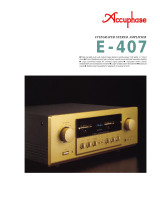
ES Receivers v1.0 Page 8
this way, jitter is completely eliminated—and the integrity of the original
musical signal is restored.
• DC Phase Linearizer (DCPL). Interaction between traditional amplifiers and
real-world loudspeakers cause significant departure from phase linearity at
frequencies below 30 or 50 Hz. These shifts have a subtle effect, creating
warmer and more accessible bass. Sony's DC Phase Linearizer gives you
several control positions, including Off, enabling you to adjust low-frequency
phase shift and restore this effect.
• Complementary Pulse Length Modulation (C-PLM). Previous digital
amplifiers have used a 1-bit technology called Pulse Width Modulation or
PWM. Those digital amplifiers varied the width of pulses. Unfortunately,
PWM tends to expose the signal to second-order harmonic distortion. C-PLM
effectively controls the distortion, maintaining the integrity of the musical
signal.
• Synchronous Time Accuracy Controller (S-TACT). Because C-PLM
conversion expresses the music in a different digital form, the signal requires
another round of correction for time-base errors. Synchronous Time
Accuracy Controller (S-TACT), originally developed for Sony's SCD-1 Super
Audio CD player, effectively clears pulse generator jitter by referencing the
output directly to the master clock. This establishes extremely accurate pulse
timing for amazingly low distortion.
• Pulse Height Volume Control. Most digital volume controls work by Digital
Signal Processing, an approach that sacrifices detail in the least significant
bit. Sony's Pulse Height Volume control adjusts the 1-bit C-PLM stream by
adjusting the regulator that supplies voltage to the power pulse generator.
Because this method does not modify or reshape the original digital samples,
there's no loss of information, no loss of detail. Sound quality is maintained
from very low volume settings all the way to maximum.
S-Master Pro Benefits
Sony's S-Master Pro design delivers a host of benefits.
• Simplicity. Digital signals remain in the digital domain until the last possible
moment. The purity and clarity of digital source material is maintained.
• Low heat generation. With S-Master Pro, the output MOS FET transistors
simply switch between fully On and fully Off states. The transistors operate at
nearly maximum thermal efficiency. This has a profound impact on the
physical design of the power amplifier.
o The amps can be far more compact, because the heat sinks take
up far less space. This is a major consideration when you have
seven amplifiers, each putting out 170 watts per channel (all
channels driven, 8 ohms, 20 to 20,000 Hz, at 0.15% THD).





















